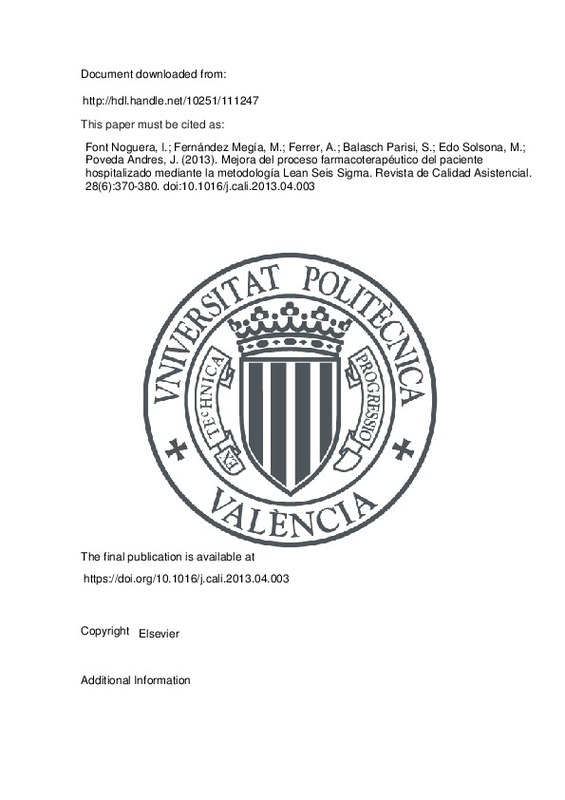JavaScript is disabled for your browser. Some features of this site may not work without it.
Buscar en RiuNet
Listar
Mi cuenta
Estadísticas
Ayuda RiuNet
Admin. UPV
Mejora del proceso farmacoterapéutico del paciente hospitalizado mediante la metodología Lean Seis Sigma
Mostrar el registro sencillo del ítem
Ficheros en el ítem
| dc.contributor.author | Font Noguera, I.
|
es_ES |
| dc.contributor.author | Fernández Megía, M.J.
|
es_ES |
| dc.contributor.author | Ferrer, Alberto
|
es_ES |
| dc.contributor.author | Balasch Parisi, Sebastià
|
es_ES |
| dc.contributor.author | Edo Solsona, M.D.
|
es_ES |
| dc.contributor.author | Poveda Andres, J.L.
|
es_ES |
| dc.date.accessioned | 2018-10-25T04:32:38Z | |
| dc.date.available | 2018-10-25T04:32:38Z | |
| dc.date.issued | 2013 | es_ES |
| dc.identifier.issn | 1134-282X | es_ES |
| dc.identifier.uri | http://hdl.handle.net/10251/111247 | |
| dc.description.abstract | [EN] Background Lean Six Sigma methodology has been used to improve care processes, eliminate waste, reduce costs, and increase patient satisfaction. Objective To analyse the results obtained with Lean Six Sigma methodology in the diagnosis and improvement of the inpatient pharmacotherapy process during structural and organisational changes in a tertiary hospital. Material and methods Scope: 1.000 beds tertiary hospital. Design prospective observational study. The define, measure, analyse, improve and control (DMAIC), were deployed from March to September 2011. An Initial Project Charter was updated as results were obtained. Population and sample: 131 patients with treatments prescribed within 24 h after admission and with 4 drugs. Variables: safety indicators (medication errors), and efficiency indicators (complaints and time delays). Results Proportion of patients with a medication error was reduced from 61.0% (25/41 patients) to 55.7% (39/70 patients) in four months. Percentage of errors (regarding the opportunities for error) decreased in the different phases of the process: Prescription: from 5.1% (19/372 opportunities) to 3.3% (19/572 opportunities); Preparation: from 2.7% (14/525 opportunities) to 1.3% (11/847 opportunities); and administration: from 4.9% (16/329 opportunities) to 3.0% (13/433 opportunities). Nursing complaints decreased from 10.0% (2119/21038 patients) to 5.7% (1779/31097 patients). The estimated economic impact was 76,800 euros saved. Conclusions An improvement in the pharmacotherapeutic process and a positive economic impact was observed, as well as enhancing patient safety and efficiency of the organization. Standardisation and professional training are future Lean Six Sigma candidate projects. | es_ES |
| dc.description.abstract | [ES] Introducción La metodología Lean Seis Sigma se utilizó para mejorar procesos, eliminar desperdicios, reducir costes y aumentar la satisfacción de clientes. Objetivo Analizar los resultados obtenidos con la metodología Lean Seis Sigma en el diagnóstico y la mejora del proceso farmacoterapéutico del paciente hospitalizado durante el cambio estructural y organizativo de un hospital terciario. Material y métodos Ámbito: hospital general terciario con 1.000 camas. Diseño del estudio: observacional y prospectivo. Se desplegaron las etapas definir, medir, analizar, mejorar y controlar (DMAIC) entre marzo y septiembre de 2011, actualizando el Project Charter inicial según resultados. Población y muestra: 131 pacientes hospitalizados con tratamientos prescritos en las 24 h siguientes al ingreso y con 4 medicamentos. Variables: indicadores de seguridad (errores de medicación) y de eficiencia (tiempos de demora y reclamaciones). Resultados La proporción de pacientes con algún error de medicación se redujo del 61,0 (25/41 pacientes) al 55,7% (39/70 pacientes) en 4 meses. Los porcentajes de errores, con respecto a las oportunidades de error, en distintas fases del proceso disminuyeron: prescripción 5,1 (19/372) a 3,3% (19/572); preparación 2,7 (14/525) a 1,3% (11/847 oportunidades); y administración: 4,9 (16/329) a 3,0% (13/433). Las reclamaciones se redujeron del 10,0 (2.119/21.038 pacientes) a 5,7% (1.779/31.097 pacientes). El impacto económico se estimó en 76.800 euros evitados. Conclusiones Se observó una mejora del proceso farmacoterapéutico y un impacto financiero positivo que ha repercutido en la seguridad del paciente y la eficiencia de la organización. La normalización y la formación de profesionales podrían ser proyectos futuros de Lean Seis Sigma. | es_ES |
| dc.language | Español | es_ES |
| dc.publisher | Elsevier | es_ES |
| dc.relation.ispartof | Revista de Calidad Asistencial | es_ES |
| dc.rights | Reserva de todos los derechos | es_ES |
| dc.subject | Metodología Lean Seis Sigma | es_ES |
| dc.subject | Seguridad del paciente | es_ES |
| dc.subject | Mejora de la calidad | es_ES |
| dc.subject | Error de medicación | es_ES |
| dc.subject | Lean Six Sigma methodology | es_ES |
| dc.subject | Patient safety | es_ES |
| dc.subject | Quality improvement | es_ES |
| dc.subject | Medication error | es_ES |
| dc.subject.classification | ESTADISTICA E INVESTIGACION OPERATIVA | es_ES |
| dc.title | Mejora del proceso farmacoterapéutico del paciente hospitalizado mediante la metodología Lean Seis Sigma | es_ES |
| dc.title.alternative | Improving inpatient pharmacoterapeutic process by Lean Six Sigma methodology | es_ES |
| dc.type | Artículo | es_ES |
| dc.identifier.doi | 10.1016/j.cali.2013.04.003 | es_ES |
| dc.rights.accessRights | Abierto | es_ES |
| dc.contributor.affiliation | Universitat Politècnica de València. Departamento de Estadística e Investigación Operativa Aplicadas y Calidad - Departament d'Estadística i Investigació Operativa Aplicades i Qualitat | es_ES |
| dc.description.bibliographicCitation | Font Noguera, I.; Fernández Megía, M.; Ferrer, A.; Balasch Parisi, S.; Edo Solsona, M.; Poveda Andres, J. (2013). Mejora del proceso farmacoterapéutico del paciente hospitalizado mediante la metodología Lean Seis Sigma. Revista de Calidad Asistencial. 28(6):370-380. doi:10.1016/j.cali.2013.04.003 | es_ES |
| dc.description.accrualMethod | S | es_ES |
| dc.relation.publisherversion | https://doi.org/10.1016/j.cali.2013.04.003 | es_ES |
| dc.description.upvformatpinicio | 370 | es_ES |
| dc.description.upvformatpfin | 380 | es_ES |
| dc.type.version | info:eu-repo/semantics/publishedVersion | es_ES |
| dc.description.volume | 28 | es_ES |
| dc.description.issue | 6 | es_ES |
| dc.relation.pasarela | S\256527 | es_ES |







![[Cerrado]](/themes/UPV/images/candado.png)

